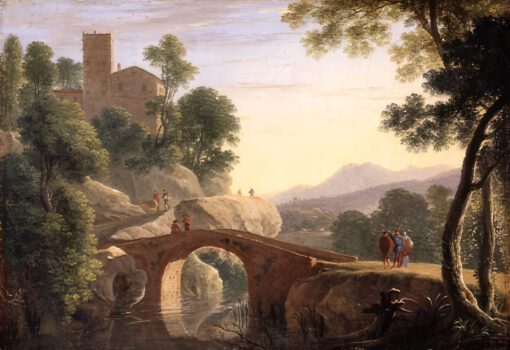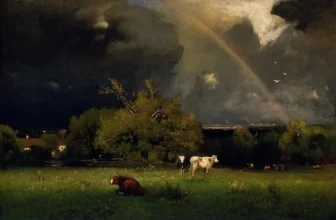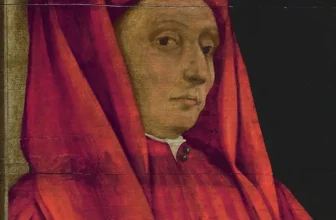The Enduring Appeal of Italian Renaissance Landscapes for Interior Design
A Luxury Dialogue Between Art and Interior Design
Shopping Ads: Invest in Hidden Masterpiece: Rare Antique Oil Paintings For Sale. Limited Originals Available 💰😊 Are you looking for authentic hidden masterpiece? Explore old master antique oil paintings from the Renaissance and Baroque eras. From 16th-century portraits to 18th-century landscapes. Authenticity guaranteed, Old Master antique oil paintings for sale. Shop Now! 🎨 Renaissance And Baroque Art Old Master Portrait Paintings Landscape Antique PaintingsThe Italian Renaissance remains one of the most transformative periods in human creativity, and its influence extends far beyond museums and art history books. From Florence to Venice, the masterpieces of this era captured not just the human form but also the divine harmony of nature. Among its many gifts to the world, Renaissance landscape painting stands out as a profound expression of balance, perspective, and beauty , values that continue to inspire modern interior design.
Today, collectors, designers, and homeowners alike are rediscovering the enduring appeal of Italian Renaissance landscapes as a source of sophistication and serenity. These paintings, with their delicate brushwork and idealized vistas, bring an old-world charm that transcends time. Whether reimagined as luxury canvas prints, framed originals, or digital reproductions, Renaissance landscapes infuse interiors with a sense of depth, culture, and classical refinement.
This topic explores why Italian Renaissance landscapes remain a cornerstone of elegant interior design , tracing their history, aesthetic qualities, and their seamless adaptation to contemporary spaces.
The Birth of Renaissance Landscape Painting
To understand the power these works hold over today’s interiors, it’s essential to revisit their origins.
During the late 14th to early 16th centuries, the Italian Renaissance revolutionized art by reintroducing humanism , the celebration of humanity, nature, and proportion. Artists began to depict the world around them not as symbolic backdrops but as living, breathing spaces filled with light and emotion.
Before the Renaissance, landscapes served primarily as settings for religious scenes, often secondary to the main figures. However, artists such as Leonardo da Vinci, Giovanni Bellini, Piero della Francesca, and Giorgione began to elevate the landscape to a subject of contemplation in its own right. They saw nature as divine geometry , a reflection of cosmic order.
Through the innovations of linear perspective, atmospheric perspective, and chiaroscuro, these artists gave landscapes a mathematical and spiritual harmony. The rolling hills of Tuscany, the tranquil lakes of Lombardy, and the sunlit skies of Umbria became eternal symbols of balance and beauty.
This deep connection to nature and proportion , key elements of the Italian Renaissance , now finds a natural home in modern interior design.
Why Renaissance Landscapes Resonate with Contemporary Interiors
In an age defined by minimalism, digital screens, and fleeting trends, Italian Renaissance landscapes offer something enduring: timeless serenity. Their compositions are both structured and poetic, evoking a deep sense of order and calm.
Here are several reasons why these artworks have maintained their appeal in modern interiors:
1. Harmony and Proportion
Renaissance artists mastered perspective and balance, creating scenes where every element feels intentional. This harmony resonates with interior designers who seek equilibrium between color, form, and space. Hanging a Renaissance landscape introduces instant architectural depth to a room, guiding the viewer’s eye through a natural visual journey.
2. Natural Color Palettes
The warm earth tones, soft greens, and luminous blues found in these paintings echo the hues of nature. Such palettes complement both classic and contemporary interiors, allowing Renaissance art to blend seamlessly with modern materials like marble, oak, brass, and linen.
3. Emotional Tranquility
Renaissance landscapes often depict idyllic countrysides bathed in gentle light. These scenes evoke peace and contemplation , qualities that make them ideal for living spaces, offices, and luxury retreats.
4. Cultural Depth
Owning or displaying art inspired by the Italian Renaissance signals not only aesthetic taste but also an appreciation for history and intellect. In luxury interior design, cultural depth often defines the distinction between opulence and mere decoration.
5. Timeless Luxury
The allure of Renaissance landscapes lies in their ability to transcend style eras. Whether placed in a neoclassical villa, an urban penthouse, or a modern minimalist apartment, these paintings retain their gravitas. They evoke luxury through subtlety rather than ostentation.
The Italian Landscape: A Symbol of Beauty and Idealism
The Italian Renaissance transformed the way humans viewed nature. Artists sought to represent landscapes not as mere depictions of geography but as idealized visions of paradise.
In Leonardo da Vinci’s “Annunciation,” the distant mountains and glowing horizon create a divine depth that mirrors human perfection. Giovanni Bellini’s pastoral scenes blend serenity and emotion, while Giorgione’s “The Tempest” captures the mysterious relationship between humans and the natural world.
These compositions balance light, atmosphere, and proportion with such precision that they became visual metaphors for human harmony within nature.
In interior design, this same philosophy inspires how designers balance textures, forms, and colors to create tranquil environments. Just as Renaissance artists sought equilibrium between heaven and earth, designers today strive for equilibrium between aesthetic and function , a direct continuation of the Renaissance ideal.
Integrating Renaissance Landscapes into Modern Interiors
Incorporating Italian Renaissance art into contemporary interiors requires sensitivity to proportion, lighting, and context. Done thoughtfully, it can create breathtaking results that bridge centuries.
1. Grand Focal Point in Classic Interiors
In homes with traditional architecture , such as those featuring coffered ceilings, marble floors, or ornate moldings , a large-scale reproduction of a Renaissance landscape can serve as a majestic focal point. Framed in gilded wood or antique bronze, it complements the grandeur while softening the space through natural imagery.
2. Contrast in Minimalist Spaces
In stark, minimalist interiors, a Renaissance landscape becomes a powerful contrast. Its rich tones and organic textures introduce warmth and narrative. The juxtaposition of a centuries-old vista against clean lines and monochrome surfaces creates visual tension and sophistication , a popular strategy in luxury art interiors.
3. Gallery Wall Arrangements
For a curated, contemporary approach, several smaller landscape prints can be arranged as a gallery wall. Combining works by different Renaissance masters allows the collector to tell a story through composition and evolution , from early linear perspectives to the more atmospheric moods of the Venetian school.
4. Textile and Wallpaper Inspirations
Modern interior design often reinterprets Renaissance motifs through textiles and wallpaper patterns. Murals inspired by Tuscan countrysides or fresco-like backdrops add architectural depth and evoke the grandeur of Italian villas.
5. Digital Renaissance: Canvas Prints and Giclée Art
With advancements in high-resolution printing, Renaissance landscapes are now accessible as museum-quality canvas reproductions. These prints maintain the original texture and luminosity of oil painting while allowing designers flexibility in scale and finish , ideal for luxury hotels, estates, and private residences.
The Emotional Resonance of Renaissance Landscapes
Beyond their visual beauty, Renaissance landscapes connect on a profound emotional level. Their balance of human and natural elements reflects a deep yearning for unity , something still relevant in modern life.
When displayed in interiors, these works evoke calm, stability, and inspiration. The soft perspective lines draw viewers inward, creating a sense of space even in smaller rooms. They remind us of a world where time moved slower, where beauty was a reflection of divine order.
Psychologically, viewing serene landscapes can reduce stress and promote wellbeing , a principle supported by biophilic design, which emphasizes the human need for nature. Renaissance art, with its perfect equilibrium between civilization and landscape, anticipates this modern theory by centuries.
Thus, displaying these paintings is not merely decorative , it’s restorative.
Renaissance Aesthetics in Modern Luxury Design
The modern luxury market increasingly looks to classical art for inspiration. The quiet opulence of Renaissance aesthetics , symmetry, proportion, and light , aligns perfectly with today’s understated luxury trend.
Designers such as Axel Vervoordt, Kelly Wearstler, and Jean-Louis Deniot often incorporate classical references subtly through artwork, palette, and form. Italian Renaissance landscapes, with their timeless balance, serve as key visual anchors in such environments.
Key Design Principles Derived from Renaissance Art:
Symmetry: Borrowed from architecture and painting, symmetry enhances order and calm.
Natural Light: Renaissance art celebrates light as divine energy; designers mirror this by maximizing illumination to highlight texture and tone.
Perspective: Just as painters used linear perspective, designers use spatial arrangement to guide visual flow.
Material Harmony: Stone, wood, linen, and gold , materials favored during the Renaissance , bring natural harmony and tactile richness to interiors.
The result is a design language that feels both historic and modern , an elegant conversation between centuries.
The Role of Italian Craftsmanship
Italy’s artistic legacy is inseparable from its craftsmanship. Renaissance painters were not only artists but also innovators in pigments, perspective, and materials. Their pursuit of perfection echoes in modern Italian design , from furniture to architecture.
Contemporary Italian brands such as Poltrona Frau, Boffi, and Fendi Casa embody this spirit of craftsmanship and proportion. Integrating a Renaissance landscape into such interiors feels organic because both share a foundation in artistry and refinement.
Furthermore, bespoke framing, hand-stretched canvases, and archival printing uphold this standard of excellence, ensuring that art continues to represent the pinnacle of cultural sophistication.
Collecting and Curating Renaissance Landscape Art
For collectors and connoisseurs, acquiring or displaying Renaissance landscapes , whether originals, limited-edition prints, or inspired works , is an act of cultural preservation.
1. Authentic Works and Reproductions
While authentic Renaissance paintings are museum treasures, expertly reproduced giclée prints allow collectors to enjoy their beauty without the constraints of rarity or fragility. The key is fidelity , using fine pigments and canvas textures that capture the essence of the original.
2. Pairing with Architecture
These works thrive in environments that respect their proportions. Classical molding, natural stone, and warm lighting enhance their visual impact.
3. Thematic Curation
A curated collection might focus on regional landscapes , Venetian lagoons, Tuscan hills, or Umbrian valleys , to create a cohesive narrative. Such curation transforms interiors into private galleries celebrating Italy’s natural and cultural heritage.
4. Lighting and Preservation
Proper lighting is essential. Warm LED lighting replicates the glow of candlelight, allowing the colors to breathe without causing deterioration. Museum-grade glass and UV-protective coatings maintain the artwork’s longevity.
Rebirth of the Renaissance Spirit
While traditional landscapes remain highly valued, many contemporary artists reinterpret Renaissance ideals through modern lenses. These reinterpretations blend the spatial harmony and luminous atmosphere of Renaissance art with abstract or digital techniques.
Such works appeal to younger collectors seeking classical depth with a modern twist. They integrate seamlessly into interiors that combine historical reverence with contemporary innovation , the same synthesis that defined the original Renaissance.
Luxury designers often commission custom pieces inspired by Bellini or Da Vinci but rendered with minimalist color schemes or abstract layering. The goal is not imitation but continuation , keeping the Renaissance spirit alive in a new aesthetic language.
The Italian Landscape as a Symbol of Timeless Living
Italian landscapes have long symbolized la dolce vita , the sweet life rooted in nature, art, and proportion. From the vineyards of Chianti to the coastlines of Amalfi, this landscape embodies serenity and cultural richness.
Incorporating Renaissance interpretations of these vistas into interiors offers more than decoration; it creates an atmosphere of cultivated living. The art becomes a portal to a world of timeless beauty and philosophical depth.
For homeowners and designers alike, Italian Renaissance landscapes represent a connection to enduring values: balance, grace, and the pursuit of beauty.
Sustainability and Longevity in Art-Inspired Design
Interestingly, the Renaissance ethos aligns closely with today’s sustainable design movement. Renaissance artists valued craftsmanship, longevity, and natural materials , qualities now prized in eco-conscious interiors.
Choosing art reproductions printed with archival inks on sustainably sourced canvas or paper ensures not only aesthetic excellence but also environmental responsibility. This continuity between past and present strengthens the appeal of integrating Renaissance art into modern spaces.
The Future of Classical Art in Interior Design
As design trends evolve, the fascination with classical art endures. While futuristic and minimalist aesthetics dominate certain markets, the demand for meaningful art that conveys heritage continues to grow , especially among luxury buyers and global collectors.
The Italian Renaissance offers a wellspring of inspiration because it represents more than beauty; it embodies intellectual and emotional depth. Its landscapes, filled with light, order, and soul, speak to the universal desire for harmony , a quality every great interior strives to achieve.
The future of art-inspired design will not reject history but reinterpret it , merging digital craftsmanship with classical ideals. Renaissance landscapes, reborn through new media, will continue to grace walls, textiles, and even virtual interiors with their eternal calm.
The Eternal Light of the Renaissance
The enduring appeal of Italian Renaissance landscapes in interior design lies in their ability to bridge past and present , to offer spaces not just decoration, but meaning. They remind us that true beauty lies in proportion, light, and balance , qualities that never go out of style.
From the serene hills of Tuscany to the azure skies of Venice, these painted worlds invite tranquility and reflection. They enrich interiors with cultural weight and emotional warmth, elevating living spaces into sanctuaries of timeless art.
In an age of rapid change, the Italian Renaissance landscape stands as a symbol of continuity , proof that harmony, craftsmanship, and reverence for nature will forever define the essence of beautiful design.




